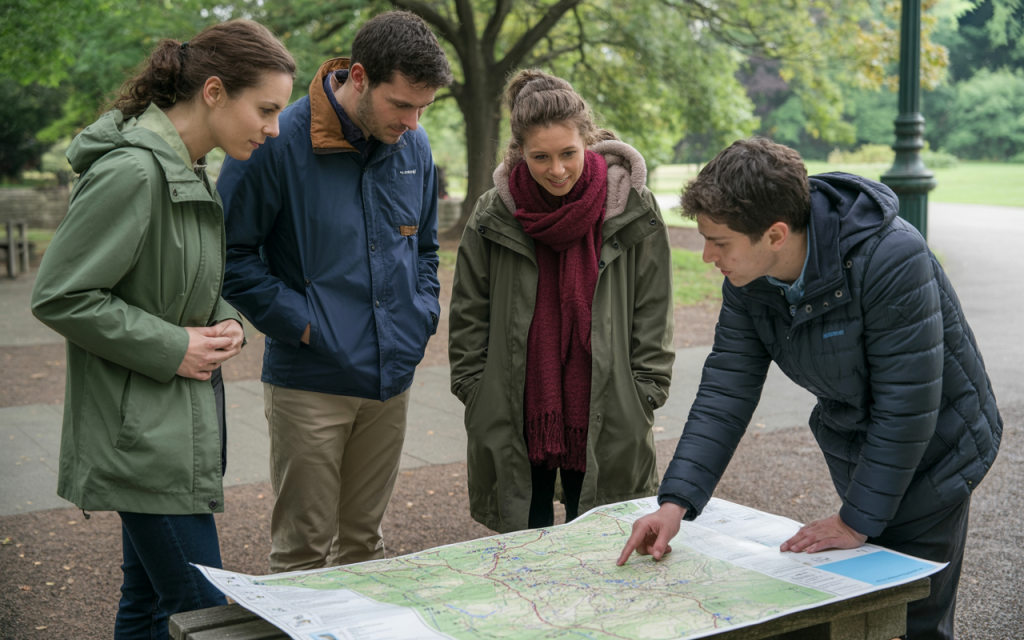Walking Meetings: Powerful Comeback for Better Work
Reinventing the Meeting: How Walking Meetings Boost Productivity and Health

Walking meetings are becoming popular again in workplaces around the world. More and more companies and teams are choosing to have conversations and discussions while walking, instead of sitting in a conference room or staring at a screen. But why are walking meetings making a comeback, and are they really better than traditional meetings? This article will explain everything you need to know about walking meetings, including their benefits, how to make them work, and answers to common questions—all in simple, easy-to-understand language.
What Are Walking Meetings?
A walking meeting is exactly what it sounds like: a meeting that takes place while walking. Instead of sitting around a table, people discuss work topics as they walk together, usually outside or in a large indoor space. Walking meetings can be one-on-one or include small groups. They are informal and relaxed, but still focused on getting work done.

Why Are Walking Meetings Making a Comeback?
There are several reasons why walking meetings are becoming popular again:
- People want more movement: Many jobs now involve sitting for long hours, which can hurt health and energy levels.
- Better creativity and focus: Walking can help people think more clearly and come up with new ideas.
- Less screen time: After years of video calls and virtual meetings, people are looking for ways to connect in person.
- Improved well-being: Walking is good for both physical and mental health, and can reduce stress.
The Science Behind Walking Meetings
Research shows that walking meetings have real benefits for both individuals and teams:
- Increased creativity: Studies have found that walking can boost creative thinking by up to 60% compared to sitting.
- Better focus: Walking helps people concentrate and stay engaged in conversations.
- Improved mood: Physical activity releases endorphins, which make people feel happier and less stressed.
- Health benefits: Walking burns calories, strengthens muscles, and improves heart health.

Benefits of Walking Meetings
Here are some of the main benefits of walking meetings:
1. More Movement, Less Sitting
Sitting for long periods is bad for your health. Walking meetings help people move more and break up long periods of sitting.
2. Better Ideas and Problem Solving
Walking can help people think outside the box and come up with new solutions to problems.
3. Stronger Team Connections
Walking together creates a relaxed, friendly atmosphere that helps people connect and build trust.
4. Less Stress
Being outside and moving around can help reduce stress and improve overall well-being.
5. More Energy
Walking boosts energy levels, making people feel more alert and ready to work.
6. Fewer Distractions
Without phones, computers, or other devices, people can focus better on the conversation.

Table: Walking Meetings vs. Traditional Meetings
| Feature | Walking Meetings | Traditional Meetings |
|---|---|---|
| Location | Outside or indoors, moving | Indoors, sitting at a table |
| Physical activity | Yes, walking | No, sitting |
| Creativity | Higher | Lower |
| Focus | Better | Can be distracted |
| Team connection | Stronger | Can feel formal |
| Health benefits | Many (exercise, mood, energy) | Few |
| Distractions | Fewer | More (phones, screens) |
How to Make Walking Meetings Work
If you want to try walking meetings, here are some tips to make them successful:
1. Plan Ahead
Choose a safe, quiet place to walk. Make sure everyone knows the route and the purpose of the meeting.
2. Keep Groups Small
Walking meetings work best with one to four people. Large groups can be hard to manage while walking.
3. Dress Comfortably
Wear shoes and clothes that are good for walking. Check the weather and dress appropriately.
4. Set Clear Goals
Know what you want to discuss and what decisions need to be made.
5. Bring Notes or Devices if Needed
If you need to refer to notes or documents, bring a small notebook or tablet. Try to keep screens to a minimum.
6. Be Mindful of Pace
Walk at a comfortable pace for everyone. Don’t rush or walk too slowly.
7. Follow Up
After the meeting, send a quick summary of what was discussed and any next steps.

Real-Life Examples
Many companies and organizations are using walking meetings with great success:
- Tech companies: Some tech teams have walking meetings to brainstorm new ideas and solve problems.
- Schools and universities: Teachers and staff use walking meetings to discuss plans and share ideas.
- Healthcare: Doctors and nurses have walking meetings to coordinate patient care and reduce stress.
Common Challenges and How to Overcome Them
Walking meetings are not always perfect. Here are some common challenges and how to handle them:
- Weather: Bad weather can make it hard to walk outside. Have a backup plan, like walking indoors or using a covered area.
- Accessibility: Not everyone can walk for long distances. Make sure everyone is comfortable and can participate.
- Noise: Outside noises can make it hard to hear. Choose quiet routes and walk at a steady pace.
- Note-taking: It can be hard to take notes while walking. Use a voice recorder or take quick notes after the meeting.

How to Encourage Walking Meetings in Your Workplace
If you want to promote walking meetings at your job, here are some ideas:
- Lead by example: Start having walking meetings yourself and share your experience.
- Educate others: Share the benefits of walking meetings with your team.
- Make it easy: Suggest walking routes and times that work for everyone.
- Get support: Ask managers or leaders to support and encourage walking meetings.
The Future of Walking Meetings
As more people learn about the benefits of walking meetings, they are likely to become even more popular. Some companies are even designing offices with walking paths and outdoor meeting spaces. In the future, walking meetings could become a normal part of how we work and communicate.

Frequently Asked Questions (FAQs)
Q: What is a walking meeting?
A: A walking meeting is a meeting that takes place while walking, instead of sitting in a room.
Q: Why are walking meetings better than traditional meetings?
A: Walking meetings help people move more, think creatively, and feel less stressed. They also build stronger team connections.
Q: How many people can join a walking meeting?
A: Walking meetings work best with one to four people. Larger groups can be hard to manage.
Q: What if the weather is bad?
A: Have a backup plan, like walking indoors or using a covered area.
Q: Can everyone join a walking meeting?
A: Not everyone can walk for long distances. Make sure everyone is comfortable and can participate.
Q: How do you take notes in a walking meeting?
A: Use a voice recorder or take quick notes after the meeting. Try to keep screens to a minimum.
Q: How do you convince others to try walking meetings?
A: Share the benefits, lead by example, and make it easy for others to join.
Q: Are walking meetings good for health?
A: Yes, walking meetings help people move more, reduce stress, and improve overall well-being.
Q: Can walking meetings help with creativity?
A: Yes, research shows that walking can boost creative thinking and problem-solving.
Q: What should you bring to a walking meeting?
A: Wear comfortable shoes and clothes. Bring a small notebook or tablet if you need to refer to notes.
How to Track the Success of Walking Meetings
To see if walking meetings are working for your team, you can:
- Ask for feedback: Talk to your team about their experience and what they liked or didn’t like.
- Measure results: Look at the quality of ideas and decisions made in walking meetings.
- Track participation: See how many people join walking meetings and how often they happen.

The Role of Walking Meetings in Remote Work
Even in remote or hybrid work environments, walking meetings can be useful. Some teams have walking meetings while talking on the phone or using wireless headphones. This helps people stay active and connected, even if they are not in the same place.
The Importance of Movement at Work
Movement is important for health, productivity, and happiness. Walking meetings are just one way to add more movement to your workday. Other ideas include standing desks, stretch breaks, and walking breaks.
How Walking Meetings Help with Stress
Stress is a big problem in many workplaces. Walking meetings help reduce stress by:
- Giving people a break from screens and sitting
- Providing fresh air and a change of scenery
- Encouraging social connection and teamwork
How to Make Walking Meetings a Habit
To make walking meetings a regular part of your work routine, try these tips:
- Schedule them: Put walking meetings on your calendar, just like any other meeting.
- Set reminders: Use your phone or email to remind yourself and others.
- Start small: Begin with one or two walking meetings per week and build from there.
- Celebrate success: Recognize and celebrate the benefits of walking meetings with your team.

The Connection Between Walking and Productivity
Walking is not just good for health—it also helps people work better. Studies show that people who move more during the day are more productive, creative, and satisfied with their work.
How to Handle Difficult Conversations in Walking Meetings
Walking meetings can be a good way to have difficult conversations. The relaxed, informal setting can make it easier to talk about tough topics. Here are some tips:
- Choose a quiet, private route
- Walk at a comfortable pace
- Listen carefully and be respectful
- Take breaks if needed
The Impact of Walking Meetings on Team Culture
Walking meetings can help build a positive, healthy team culture. They encourage openness, trust, and collaboration. Teams that walk together often feel more connected and motivated.
How to Introduce Walking Meetings to New Teams
If you are introducing walking meetings to a new team, start with a simple explanation and a short trial. Show people the benefits and make it easy for them to join. Be patient and listen to feedback.

The Role of Leaders in Promoting Walking Meetings
Leaders play an important role in making walking meetings successful. By supporting and participating in walking meetings, leaders set a good example and encourage others to try them.
The Benefits of Walking Meetings for Mental Health
Walking meetings are good for mental health. They help people feel less anxious, more relaxed, and more positive. Walking also helps clear the mind and improve mood.
How to Make Walking Meetings Fun
To make walking meetings more enjoyable, try these ideas:
- Choose interesting routes
- Bring snacks or drinks
- Play light music or podcasts
- Invite guests or experts to join

The Long-Term Benefits of Walking Meetings
Over time, walking meetings can lead to:
- Better health and fitness
- Stronger team relationships
- More creativity and innovation
- Higher job satisfaction
Conclusion
Walking meetings are making a comeback for good reason. They help people move more, think creatively, and feel better at work. Whether you are looking for a way to boost productivity, reduce stress, or build a stronger team, walking meetings are a simple and powerful solution. Try them out and see the difference for yourself!




